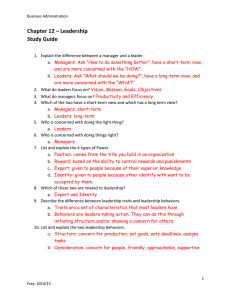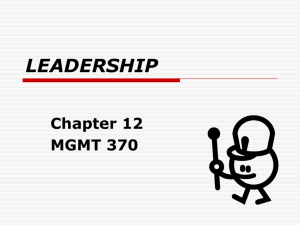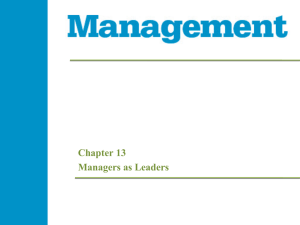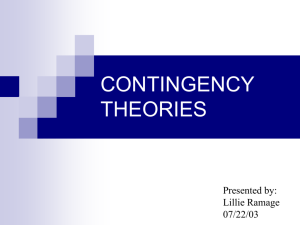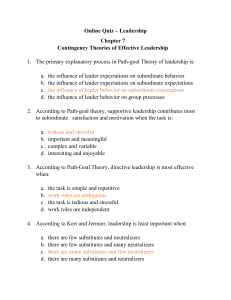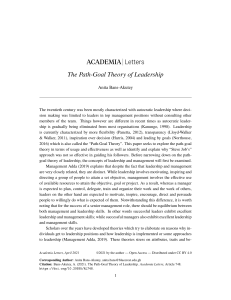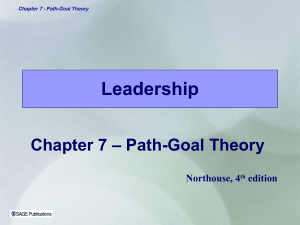Leadership Theories & Models: Contingency, Path-Goal, Continuum
advertisement
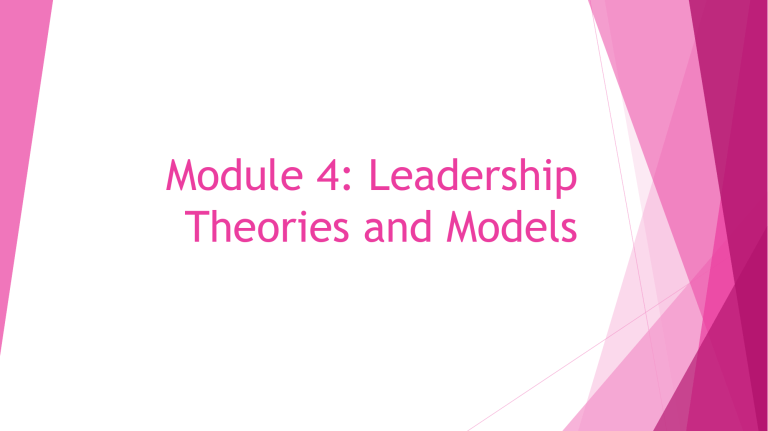
Module 4: Leadership Theories and Models Objectives Overview of Contingency Leadership Theory, Continuum Theory, Path-Goal Leadership Theory and Leadership Substitutes Theory Explain the differences between the four theories Describe how the Path-Goal Theory could be implemented in my organization Contingency Leadership Theory https://www.business2community.com/strategy/business-needs-contingency-plan-0901628 Continuum Theory https://www.managementstudyguide.com/images/continuumleadership.gif Path-Goal Leadership Theory https://encryptedtbn0.gstatic.com/images?q=tbn:ANd9GcRvaJGL45qx7tsJ_7vBbx7yoj9Y85hOJ7aRv0lqDT4YUAyka0yA wA Leadership Substitutes Theory https://www.irisreading.com/wp-content/uploads/2013/09/Substitution.jpg Contingency Leadership is prescriptive Task/Relationship centered Situation What’s the Difference? Performance Directive/Achievement/Supportive/Participative Contingency Leadership Theory Continuum Theory Path-Goal Leadership Theory Leadership Substitution Theory Continuum and Path-Goal theories are descriptive Leadership style Performance/Job satisfaction Leadership Substitutes Theory is neither prescriptive and descriptive. It is dependent on the characteristics of the followers, task or organization. Leadership may substituted or neutralized. Applying the Path-Goal Leadership Theory Of the four theories explored here, the Path-Goal Leadership Theory is the best fit for my organization. Four leadership styles are defined that consider the task and the employee. The participative style most applicable in my department, because of the ability level required, the task complexity and the internal locus of control. My department is very self-directed when it comes to problem solving in our daily work. No context is the same and therefore, in order for leadership to make progress towards the organizations goal we must be involved in leading. The situational factors identified by the Path-Goal model are subordinate and environment. Consideration of these two variables is applicable in my organization because of the complexities of a statewide agency. Continued Problem identified and defined Leader decides how to solve, keeping in mind the subordinates acceptance or commitment against a decision Situation dictates the level of group participation in the decision making process. References Lussier, R. N., & Achua, C. F. (2016). Leadership: theory, application & skill development. Boston, MA, USA: Cengage Learning. Shaukat, A. R., & Sikandar, A. (2018). Impact of leadership style of teacher on the performance of students: An application of hersey and blanchard situational model. Bulletin of Education and Research, 40(3), 73. Retrieved from https://search.proquest.com/docview/2254496824?accountid=34574
